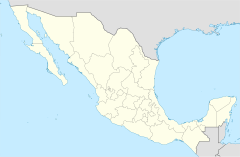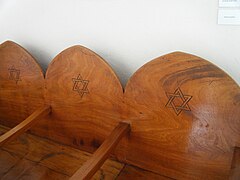| Historic Synagogue Justo Sierra 71 | |
|---|---|
 | |
| Religion | |
| Affiliation | Orthodox Jewish |
| Location | |
| Location | Mexico City |
| Country | Mexico |
| Geographic coordinates | 19°26′6.5″N 99°7′41.5″W / 19.435139°N 99.128194°W |

The Historic Synagogue Justo Sierra 71 or Synaguoge Nidjei Israel is an old Ashkenazi synagogue in Mexico City. [1] The building serves both as a synagogue and cultural center of the Jewish community in the historic center of Mexico City (Spanish: Centro Histórico de la Ciudad de México). It was constructed in 1941. [2]
It is open to the entire public. It offers guided tours and activities with the goal of promoting the space and Jewish culture, not for profit. After its restoration was completed in 2009, the Synagogue opened its doors to share its beauty, history and other expressions of Jewish culture in Mexico with the public. It is the only synagogue that holds the title of Historic Synagogue in Mexico and is one of the oldest in Mexico City.
History
The Nidjei Israel Synagogue is the third oldest in Mexico City, and the first founded by Ashkenazi Jews. This religious site was built for Orthodox Jewish immigrants from Poland, Russia, and Lithuania in La Merced neighborhood. It was the second Ashkenazi synagogue in Mexico City.
Architecture
The architect Raquel Franklin claimed that the building's Torah ark was influenced in its design by that of the synagogue of Shavel ( Šiauliai) in Lithuania. The architect, Franklin said this:
"The double facade of Nidjei Israel is significant: it leaves the office building towards the street, with a Neo-colonial facade in line with the colonial surroundings of the Historic Center, and which surely followed the tax incentives offered for any construction representing that style; The interior facade of the main building shows the influence of 19th century synagogue designs, inspired by the Neo-Romanesque."
According to Mónica Unikel-Fasja in her book Synagogues of Mexico wrote:
“The monumentality of the bimah (sort of pulpit) is impressive, undoubtedly the most elaborate of those existing in Mexico, placed in the center in the Ashkenazi fashion. It is made of richly carved wood with cut glasses describing musical instruments: drum, harp, zither and lute, as well as recurring Jewish symbols: the talit (religious shawl), palm leaf, citron and the Star of David among sacred prayers"
The Nidjei Israel Synagogue was created based on the need for prayer spaces as the Ashkenazi Jewish community of Mexico City grew. The synagogue functioned as a ceremonial, study, celebration and community work center until the mid-1960s. It remained closed for over three decades, but on December 13, 2009 it was re-inaugurated with a community event and reopened to house various cultural and religious activities.
Gallery
- Synagogue Nidjei Israel
See also
References
External links
- Synagogues in Mexico
- Religious buildings and structures in Mexico City
- Historic center of Mexico City
- Jewish communities in Mexico
- Ashkenazi synagogues
- Ashkenazi Jewish culture in Mexico
- European-Jewish culture in Mexico
- Immigration to Mexico
- Jews and Judaism in Mexico City
- Lithuanian diaspora in North America
- Lithuanian-Jewish diaspora
- Orthodox synagogues
- Orthodox Judaism in North America
- Polish diaspora in North America
- Polish-Jewish diaspora
- Russian diaspora in North America
- Russian-Jewish diaspora in North America
- 1941 establishments in Mexico
- Synagogues completed in 1941
- Russian diaspora in Mexico





